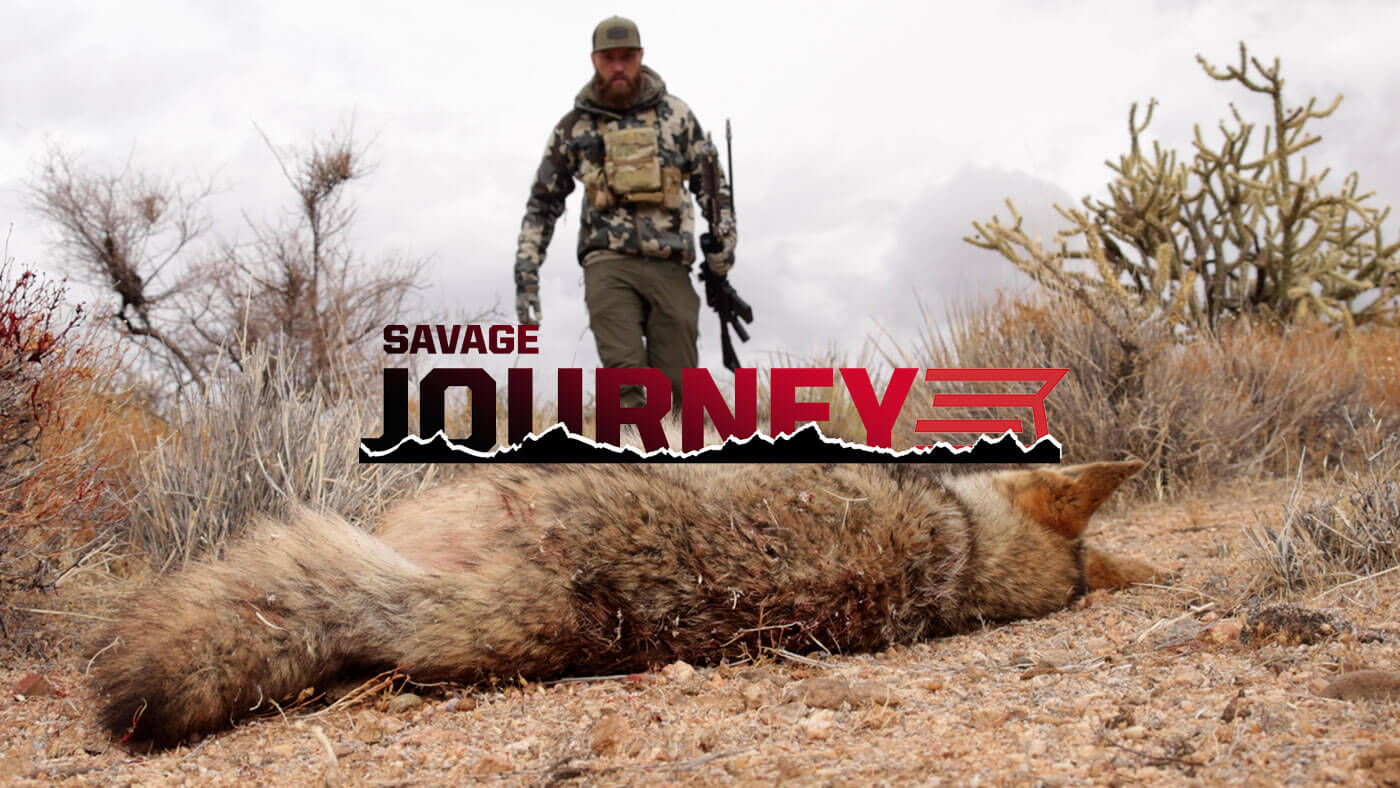- Savage Blog
- Becoming a Better Predator Hunter | Savage Journeys
Becoming a Better Predator Hunter | Savage Journeys

Savage ambassador and hunting guide, Kyle Kuechel of Yuma, AZ has spent years learning from his mistakes and overcoming obstacles on his Savage Journey to become a better predator hunter. Weather conditions, terrain, endless options for gear, and coyotes’ survival mentality are all challenges that predator hunters face but keep hunters like Kuechel coming back for more.
Why Coyote Hunt?
Coyotes are one of the most fascinating species we have in North America. They have a will to live that is rivaled by none. They are adaptable and live in every imaginable area – from the deserts of Arizona to the suburban neighborhoods, from the farmlands and prairies of the Midwest to urban streets. Coyotes are everywhere. They are tough creatures and have a well-earned reputation for being wily.
Coyote hunting is often misunderstood by hunters and non-hunters because coyotes are not game animals. But they do have a tremendous impact on game animals and cattle by preying on fawns and calves. If you are a big game hunter, it is important to recognize the role coyotes play in the larger ecosystem and to understand the pressure they put on big game animals like deer, antelope, and elk.
Hunting coyotes can be an important conservation tactic when oriented towards helping big game animals sustain or increase their populations and give fawns a better chance to survive. Effective coyote hunters can help manage the population so big game animals can flourish.
The Hunt That Never Ends
Predator hunting is the perfect answer for hunters like Kuechel who are still itching to hunt even after big game seasons have ended. Arizona has an open season on coyotes, which means they can be hunter all year with only a valid hunting license. Kuechel grew up hunting Coues whitetail deer, mule deer, elk, and big horn sheep with his dad but started looking for something to hunt during the big game off-seasons and to help sustain his favorite big game populations. He became hooked on predator hunting immediately.
Kuechel’s entry into predator hunting started with a failure when he shot right over the top of a coyote. “That was probably one of the best things that could’ve happened to me on that stand because it made it insatiable,” says Kuechel. That mistake set him off on a journey to chase the coyotes of Arizona forever. Along the way, he has acquired the experience and skills of a formidable predator hunter.
Predator Gear
After countless stands, Kuechel has learned that better gear makes him a better predator hunter. A successful predator hunter always approaches each stand with a “always be ready” mindset, which means your rifle set up needs to be optimized for predators. Kuechel’s first predator mistake shooting over the top of a coyote happened because he was sighted in for 250 yards, but the coyote was much closer, and he didn’t account for an appropriate holdover. Now, he spends the time to make sure his rifle is dialed in where he wants it, ranges landmarks before he starts calling and practices shooting holdovers.
Kuechel shoots an MSR 10 Hunter in 6.5 Creedmoor with a Vortex Viper PST Gen II 3-15x44 FFP. “One of the most essential pieces of gear for predator hunting is having a good rest and stability, so you can be confident in every shot,” says Kuechel. A good bipod system is critical!
“I’ve messed up a lot of stands by forgetting a piece of gear,” says Kuechel, but he rarely has a gear-related mistake now. Rifle, scope, ammo, bipod, suppressor, binoculars, range finder, wind checker, sling, radio, GPS, electronic caller, remote, and hand calls are all part of what he brings to every stand.

Challenges of Predator Hunting
Kuechel thinks about a lot of things when he goes into a stand – wind direction is the most important. All predator hunters know to keep the wind in their face and the sun at their back. Sometimes the wind changes or elements in the landscape prevent him from approaching a stand with favorable wind and sun directions. Kuechel tries to never give up the wind direction.
Planning his hunts in advance is a way Kuechel tries to tip the scales in his favor. He spends hours looking at wind and weather models so he can develop a plan on where to hunt and how he’s going to approach stands. Doing the homework pays off in the end.
The terrain in southern Arizona is always a factor for Kuechel. Everything has thorns, everything bites and everything is out to get you. Preparing for a grueling day in and out of stands is part of the challenge and a part of the fun for Kuechel.
“If it was easy, I think the fun would die out real fast,” says Kuechel.
The Journey
Every time Kuechel goes out to the field, there is a challenge to overcome. Overcoming difficulties is what keeps him going back into the field time and time again. “I still get that rush when there’s a coyote coming into the call. That rush is what I’m chasing every time I call in a coyote,” says Kuechel.
Kuechel is still learning from his mistakes and that’s why he keeps chasing coyotes. This is a hunter’s journey and what carries Kuechel’s to the next stand and continue his Savage Journey.

